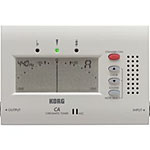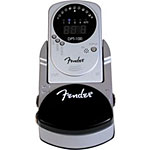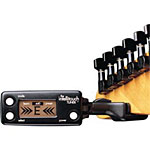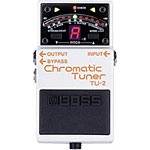Guitar Tuners
Buyer's Guide
Before you spend money on one or more guitar tuners, spend a few minutes reading through this guide.
Why? Because what you intend to do with your tuner, the type of guitar you have, and where you intend to use the tuner all factor in to your purchase decision. In fact, if you're like most guitar players, you'll end up with multiple guitar tuners. Buying the right tuners the first time will save you money in the long run.
I'll cover a number of popular and versatile tuners, plus a couple others that are less popular, but might be perfect for some applications. At the end of the page, I'll give you my recommendations.
Online Tuners
If you don't have your own guitar tuners yet... if you're battery's dead... if you want to explore alternate tunings, try one of the many online tuners.
To use most online tuners you click on the name of a string or note. You'll hear that note through your PC speakers. This is your reference pitch. Next, you must adjust your tuning key until the pitch of your guitar string matches the reference pitch.
Now there's a better way, however. Our friends at SeventhString.com, makers of the wonderful Transcribe! tool, have posted an easy to use online chromatic guitar tuner!
I also like the versatile online tuner from Get-Tuned.Com. It's a "hear and adjust" type tuners, but in addition to standard tuning (EADGBE), you can also select a number of alternate tunings. Even if you don't need to use an alternate tuning (such as Drop-D or Open-G) it's fun to click on the Tuning Presets to see how you might tune your guitar.
Tuning Forks And Pitch Pipes
Though no longer favored by most guitarists, some still use tuning forks (sometimes called pitch forks) and pitch pipes.
A tuning fork produces one note, or pitch. You tune one string to that note, then tune the others to this in-tune string. Tuning forks costs about $9 each. For information on how to do this, see the discussion of Relative Pitch Tuning Methods.
Pitch pipes produce a set note when blown into. They are available in two varieties: a six-note pipe or a chromatic pipe.
The six-pitch pipe can produce one note for each string found on the guitar: EADBG and E.
A chromatic pitch pipe is circular, and has additional tubes. With it, you can produce 12 (sometimes 13) notes of one scale. Chromatic pitch pipes are often used by vocalists. I would not recommend one for guitar tuning unless you have a specific purpose in mind. Prices range from $3 to $20.
Advantages:
- Inexpensive.
- Easy to produce standard tuning tones.
- It helps you develop an ear for what's in-tune.
Disadvantages:
- Inflexible.
- No visual clues to assist you.
- Difficult to use in a noisy environment.
Electronic Guitar Tuners
Electronic guitar tuners are the most accurate and probably easiest way to tune your guitar. By helping you match your guitar to a set of standard pitches, you can be certain that your open G-note sounds the same as everyone else's open G-note.
Electronic tuners work by comparing a known pitch to the pitch produced when you pluck a string. The tuner determines if you are too low, too high, or the same as that pitch. Too low and the needle (or lights) point left... your note is flat. Too high and the needle (or lights) point right... your note is sharp. Just right... the needle (or light) is centered.
Electronic guitar tuners come in a wide variety of shapes and sizes, including some places where you might not expect them. In addition to individual devices, you can find them in foot pedals, guitar effects boxes, recording software, music notation software, and rack-mounted components.
Key Features Of Electronic Guitar Tuners
- 1/4" Phone Plug Input - For tuning in noisy environments.
- Battery Powered - For portability.
- Built-In Microphone - For guitars without electronics.
- Stable Response - For certain tuning without frustration.
- Chromatic Note Detection - For tuning to practically any note.
Other Features To Consider
- Adjustable Pitch - In case you play along with a non-tunable instrument.
- Built in Metronome - Some people swear by them, others hate them.
- Input/Output Bypass - When you need to tune without others hearing you (such as on stage).
- Oversized Display - For viewing at a distance (such as on stage) or with weak eyes.
Recommendations
| If you can connect your guitar to your computer, try out Seventh String Software's Online Chromatic Tuner. Lot's of help on the same page, and you can download it for use when you're not online. Cost: Free! | |
| The
Korg CA1 Chromatic Tuner
|
 |
| The
Korg CA-40 Electronic Chromatic Tuner
|
 |
| Headstock Tuners eliminate cables, and the latest crop are do not suffer from signal drop-out of earlier versions. The Intellitouch PT-30 is easy to use, easy to read, works on all guitars, and even includes three selectable backlight colors! |  |
| Sometimes you need a stage-ready pedal tuner, and sometimes you need a pocket tuner. The
Fender DPT-100 Detachable Pedal Tuner
|
 |
| The
Intellitouch PT1 Tuner
|
 |
| Pay attention to the stage equipment of your favorite band, and you may just see the highly praised
Boss TU-2 Chromatic Stompbox Tuner
|
 |


